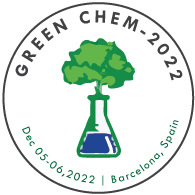Welcome message
A very warm welcome to attend the 13th International conference on Green Chemistry & Engineering which is going to happen on December 05-06,2022 in Barcelona, Spain. We cordially invite all researchers, scientists, professors and all who are interested in sharing their views about sustainable environment or Green chemistry 2022 and Recyclable, environmentally benign solvent system.
The conference will be held around the theme Environmental sustainability and recycling . Your participation is a perfect addition to us. So we will be looking forward to your participation.
For more detalied information. Click on Download our Broucher

About Conference
The main purpose of this conference is to Researchers bringing out their innovative scientific research project in green chemistry. They also analyse their data which determine the success of their research projects. This conference’s overall objective is to bring together all experts, researchers & scientists to share their information, adapt information and procedure to design and carry out an experiment on green chemistry.
This conference will help us all to explore and discover new ways to make the best future for chemical products in that way which need less reagents, smaller amounts of solvent and lesser energy to make, also helps in being safer, producing less wastage and increasing productivity. This also helps in introducing and adopting the concept of Recycling .
Why to attend
It allows all researchers and engineers to meet one another and to learn and discuss issues, ideas and work on a topic of mutual concern. You should attend because of :
· Networking Opportunities
· To learn cutting edge industry knowledge
· Improve your presentation and communication skills
· To get inspired
· To meet experts, scientist and engineers face to face
· Add research value
· new tips and tactics in your field
· Get stronger with new skills.
Who should attend
· Scientists
· Engineers
· Young research fellows
· Research fellows
· Students
· Chemical. Medical, Agri , bio, Technology Companies
· Industry professional , Professors, Doctors
· Business executives and directors
· Chemical association
· Advertising agency
Session and Tracks
Track 1: Green Chemistry and its principle
Green chemistry or sustainable chemistry in simple words that it is just a different way of thinking about how chemistry and chemistry engineering can be done. There are many principles which can be used when design, development and implementation of chemical products and principles. These principles help engineers and scientist to protect and benefit the economy. So, Green chemistry design the chemical product and process in that way which reduce or eliminate the use and development of hazardous substances.
“Green chemical is defined as environmentally benign chemical synthesis and recycling process”
Its principles are:
-
Prevention of wastage
-
Maximum incorporation of reactant into the final product
-
Minimization of hazardous products
-
Design of safe chemicals
-
Minimum energy Requirements
-
Selection of most appropriate solvent
-
Selection of appropriate starting material
-
Protecting group use should be avoided
-
Use of catalyst should be preferred
-
Product should be biodegradable
-
Manufacturing plants should be designed so that accidents eliminates during operation
-
Strengthening the Analytical technique to control hazardous compounds
Track 2 : Pollutants in ecosystem
“Green chemistry and pollutants in ecosystem” means environmental Chemistry which defines that the-state-of-the-art advances regarding that, to prevent with the pollution of water, soil, Atmosphere, food and living organism by toxic metal, fossil fuels, pesticides and other organic pollutants. Furthermore, the eco-toxicology section presents novel bio-assays. The text highlights the novel chemical relies on environmental friendly conditions. The analytical chemistry section of the volume describe very sensitive method which find the fate of pollutants in complex environment.
-
Prevention form pollution
-
Prevents from organic pollutants
-
Environmental Friendly conditions
-
Fate of Pollutants in Complex environment.
Track 3 : Environmental Benign reactions
Green Chemistry include a wide range of reactions like solid state, photochemical, sonication and enzymatic. It explains the need and principle of green chemistry including data and information related to researchers and students. The planned and detailed preparation that are required to convert the green laboratory techniques are also explained. it provide experimental details for a number of green preparation.
-
Green Chemistry reactions
-
Green Laboratory Techniques
-
Experiment detail for green preparation
-
Researchers gain various information about Principle and need of green Chemistry
Track 4 : Radical Reactions in Aqueous media
This describes the carbon hydrogen bond formation in aqueous media via radical area actions with a direct focus on hydrogen atom transfer. it is for students of academic researchers, and industrial chemist. This combines the extensive knowledge of free radical chemistry with update innovation and creative application. This covers the generation of carbon centered free radicals, solubility of subtrates and intiators.
-
Focus on Hydrogen atom transfer
-
Knowledge of free radical chemistry
-
Updated information of green chemistry
-
Generation of green chemistry radicals
Track 5 : New Trends in Green principle
The basic principle of green chemistry through new trends states : the use of green reagents
-
Green catalysts
-
Phase transfer catalysts
-
Green Synthesis
So, green chemistry microaves, ultrasound bio catalysis in detail and also liquid phase reactions and organic synthesis in the solid phase.
Track 6 : Nature’s most Renewable resource
Green chemistry provide a comprehensive overview of Chemistry of water in environment. It examines the issue of water with sustainability. The science and technology of substance to area essential to sustainability science. Green chemistry covers energy includes renewable and emerging sources. It covers the geosphere, atmosphere, biosphere, anthosphere , bio geo chemicals cycles. And maintain in a way that will enable it to operate in harmony with the environment to the generation come.
Track 7 : Environmental Chemistry
Green materials for energy, Products and depollution means Environment Sustainability. Green chemistry include several Advance technique to clean polluted water Such as Low cost filtration, ferrite photo catalysts and electrochemistry. Green chemistry show various living organism used as bio indicators of toxic metal. Green chemistry describes biodiesel production from microalgae.
-
Green Materials
-
Advance technique of Green chemistry
-
Less energy with more productivity
-
Pollution from Depollution
Track 8 : Chemical Engineering
Environmental Transport Phenomena as chemical Engineering describing mass conversation and macroscopic mass balances. Green Chemistry covers the fundamental of difussive transport, The application of diffusive equation and diffusive transport in reactive system. This majorly discuss convective transport, hydrodynamic dispersion and transport in multiphase system. This also describes spread and distribution of contaminants in the environment as well as process related to recycling .
-
Diffusive transport in Green chemistry
-
Multiphase of Green Chemistry
-
Recycling
Track 9 : Updated Clean Technology
The introduction of Green chemistry encourages new way of thinking about how products and processes are developed. Green Chemistry includes the method of waste minimization , use of renewable stocks and the role of catalysis in reduce the use of raw material. So, this way this research done : Clean technology and green chemistry.
Track 10 : Environmental remediation
Green Chemistry for Environmental remediation gives understanding about, around the planet has consolidated green science into the educational program. Green Chemistry address the natural issue by featuring the job green science plays in making the climate spotless and green covering a wide cluster of subjects going from economical turn of events, microwave substance response, microbial bioremediation, inexhaustible feed stocks, and different themes, will progress ecological improvement.
Track 11 : Global Policy in Green Chemistry
Green Chemistry provides a synopsis of the environmental challenge faced by scientist who seek to mitigate damage inflicted by human technological activities. The examples of chemical contamination are also provided in green chemistry. A brief overview of alternative energy source is also described along with a discussion of global policy with reference to potentially planet threating environmental damages.
-
Chemical Contamination
-
Global policy
-
Threat environmental Challenges
Track 12 : The Green house affect Aerosols and Climate Change
Green Houses gases absorb and emit infraded radiation. Their abilities are depending upon molecular structure. And the lifetime depends upon the chemical properties. So, Human emissions of different greenhouse gases have different impact on earth’s climate. And the climate change due to increase concentration on greenhouse gases has increase implication on human welfare and natural world.
-
Greenhouse gases affect
-
Welfare of world
-
Climate change conditions
Track 13 : The Natural Atmosphere
Green Chemistry includes the basic Physical and chemical processes that take place in the natural and unperturbed atmosphere. The green energy balance between incoming solar radiation and outgoing terrestrial is described. The key photochemical and photolysis are also explained. The overview of oxidants like OH radical, O3, NO3 racidals and the source and sinks of volatile organic compounds are described.
-
Green Energy
-
Physical and Chemical processes
-
Oxidants
Track 14 : Application in Homogenous Catalysis
Green Chemistry Principles are illustrated by the field of homogenous catalysis. Catalysis include metal complexes and various types of organocatalysis. There are covered by very selected examples. The highlight synthetic transformation from oxidations/reductions to several method of C—C , C—X , bond formation and include both racemic and enantioselected examples.
Track 15 : Biocatalysts
In Green Chemistry, Biocatalysts provide wise opportunity to reduce wastage of organic synthesis. The stereo- ,regeo- ,and chemoselective provide additional avenues for the development of industrial application of biocatalysts. Green Chemistry also include bond formation : polyketide synthases, nonribosomal peptide synthases, Diels-Alderase ribozymes, and terpenoid synthases.
-
Reduce wastage of organic syntheses
-
Application of biocatalysts
-
Bond formation (C—C )
Track 16 : Modern Applications of Green Chemistry
Green chemistry’s modern application is Renewable Energy. And renewable energy is derived from natural and sustainable processes. It includes: solar energy, wind energy, and geothermal energy. Green Chemistry covers electrochemical energy storage and delivery methods. It also covers chemistries of batteries and fuel cells.
-
Modern technology: Renewable energy
-
Various Chemistry of batteries and fuel cells
-
Natural and sustainable processes
Track 17 : Sustainable Carbon copy
Green Chemistry includes that Humanity is still depend on nonrenewable, diminishing and finite fossil fuel resources. To reduce our reliance and environmental problems, it’s time to switch from fossilized solar energy to real time solar energy. Green Chemistry also includes methanol economy, which provide us a sustainable carbon source for fuel and materials.
-
Methanol Economy
-
Real time solar energy
-
Recycling CO2 to methanol
Track 18 : Water Contamination and Pollution
Chemical, Physical or biological components or factors produce condition of impairment of a given water body with some beneficial use. In this have water pollution. Very certain natural events can cause water pollution. So, Green Chemistry describes about the water pollution. Green Chemistry also focus on the anthropogenic source of pollution that arise from human activity.
-
Water pollution
-
Anthropogenic source of pollution
-
Factors that create pollution through water
Track 19 : Heavy Metal Pollution and Remediation
Heavy metal are Naturally occur by compounds, anthropogenic activity. Which is threat on both human and eco system . Heavy metals are non-degradable and be bio accumulate in living organism. Remediation of heavy metal requires proper care to protect soil quality, ecosystem and human health. So, Green Chemistry summarizes the heavy metal and various heavy metal remediation technologies.
-
Natural Heavy metal Pollution
-
Remedy of heavy metal requires care
-
Phytoremediation
Track 20 : Organic Solvent
Solvents are important auxiliaries in processes and manufacturing. The new trend that governs solvent design, usage and recovery. The potential of emerging solvents such as ionic liquids, eutectic solvents and supercritical carbon dioxide in sustainable solvent management is highlighted in Green chemistry.
-
Solvents and their application
-
New trend of solvents
-
Sustainable solvent management
Track 21 : Solvent-free Synthesis of Nanoparticles
Green Chemistry focus on the synthesis of nanoparticles apply mechnochemical and thermal methods through solvent-free approach. For this, substantial attention is given to ball milling and mortar-and-pestel grinding. Green Chemistry describes using solvent entails stable, monodispersedfine nanoparticle that have found application in various chemical, biological and environmental field. Green chemistry also describes thermal decomposition :
-
Thermal treatment of precursor salts
-
Thermal treatment of precursor salts with capping agents
-
The use of microwave energy.
Track 22 : Chemistry in coronavirus research
Basic Researchers, Clinical and Virologists research about pathogenesis, isolation of vaccines therapies and as well as the various type of material and techniques in corona time. The molecules that understand the fundamental research that govern virus structure and function can accelerate the discovery of means to treat and prevent infectious disease. So, by the COVID-19 many researches are done on chemicals and to protect the all over world.
-
Research of various material and technique related to corona virus
-
Prevention therapies
-
Experiments in corona virus
Market Analysis
The market size of green chemistry industry is worldwide in 2015, which grows from $11 billion in 2015 to nearly $100 billion by 2020. The green Chemistry in Global Market include : Bio based Chemicals, Renewable feed stocks, green polymers and less hazardous chemicals in 2015 was some 51.7 billion US Dollar and it is forecasted by 2020, it will be some 85.6 billion US Dollars.
The market revenue of green chemistry at globally stood at $9413.1 million in 2020 , it is estimated to grow at a CAGR OF 8.9% during 2020-2030. There are many Factors responsible for the growth of market include bio based packaging, rising concern for fossil fuel depletion.
The COVID-19 pandemic affect many market globally : China, U.S, Italy, Spain and other west Europe nations. This pandemic also affect the green chemistry, Because various chemical industries are shut down. They have to face many type of losses.
Market growth Rate (2020-2030) - 8.9%
Market Size (2020) - $9,413.3 Million
Market Size (2030) - $22,039.0 Million (Estimation)
Market Size by Segments - By Product, By Application
By Product : Bio polymers, Bio solvents, Bio alcohol, Organic acids By Application : Food and beverages, Personal Care, Packaging, Automotive
Top companies of Green Chemistry and Engineering
· Sila Nanotechnologies company
· Zaiput Flow Technologies compaqny
· ZYMtronix company
· H2GO Power company
· Emew Smart System company
· Olmix company
· Sironix Renewables company
· Kalion, Inc. company
· Mitsubishi Chemical company
· BASF company
· Sinopec company
· Genesis Water Technologies , Inc. company
· Green Chemistry Centre – University of York company
· SABIC company
· LayondellBasell company
· ExxonMobil Chemicals company
Top universities of Green Chemistry and Engineering all over the world
· Massachusetts Institute of Technology
· Standford University
· Harvard University
· University of Cambridge
· University of California, Berkeley (UCB)
· University of Oxford
· National University of Singapore (NUS)
· Nanyang Technological University
· Swiss Federal Institute of Technology
· Green Chemistry Centre of Excellence
Society and Assosiation of Green Chemistry and Engineering
The ACS Green Chemistry Institute (American Chemical Society) supports the Implementation of Green and Sustainable chemistry and engineering throughout the global chemical enterprises and across the society.











